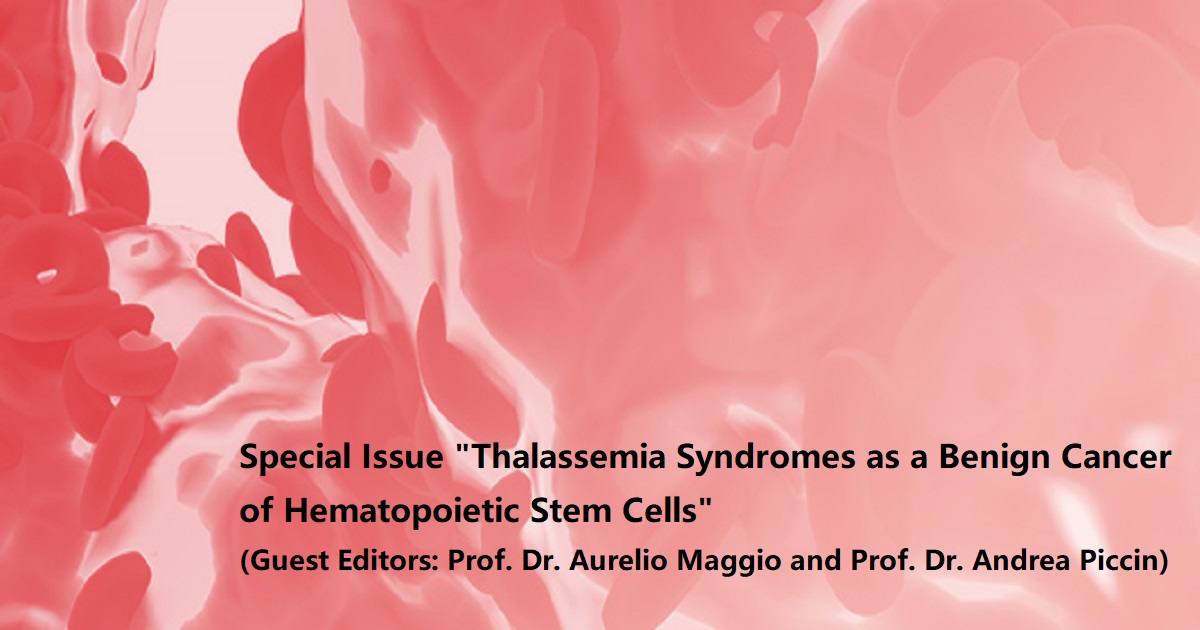Thalassemia Syndromes as a Benign Cancer of Hematopoietic Stem Cells
A special issue of Thalassemia Reports (ISSN 2039-4365). This special issue belongs to the section "Conventional Treatment of Thalassemia".
Deadline for manuscript submissions: closed (28 February 2023) | Viewed by 6749

Special Issue Editors
Interests: thalassaemia; gene; clinical trial; progenitor cell; hematopoietic stem cell; hematology
Special Issues, Collections and Topics in MDPI journals
Special Issue Information
Dear Colleagues,
The thalassemia syndrome is a genetic disorder, due mainly to more than 250 beta globin gene point mutations, affecting the proliferation of the hematopoietic stem cell leading to ineffective erythropoiesis with lack of differentiation of the erythroid clone and severe anemia. The thalassemia syndrome is not commonly perceived as a proliferative congenital hematopoietic stem cell disorder of the erythroid clone but simply as a congenital anemia. Indeed, the possibility of substituting easily and periodically the mature red cells by transfusions and of controlling iron overload by chelation, delayed research on curing this syndrome by cell approaches as was done in other acquired and congenital hematopoietic stem cell disorders of the myeloid clone. The detection of the beta039 single-nucleotide substitution in the coding region of the mRNA by Chang and Kan, in 1979, in a patient with thalassaemia major, opened the road map for the cure of thalassemia as a molecular disease, by aiming at correcting the beta globin imbalance with gene insertion and gene editing approaches. However, technical challenges, accessibility and sustainability of such strategies caused over a 40 year delay before some started becoming available at the patient bedside.
Over the last 20 years, hematopoietic stem cell disorders of the myeloid clone have witnessed a massive drug-revolution, leading to the concept of the “target cell strategy”. This is particularly true, for the mechanism of action driving Chronic Myeloid Leukaemia (CML) and the consequent development of new target drugs such as imatinib. This was followed by the development of a large pipeline of similar drugs, such as JAK-2 inhibitors like ruxolitinib for the treatment of Myeloproliferative Neoplasms (MPN). The introduction of monoclonal antibodies such as rituximab (anti-CD20) and more recently blinatumumab (anti CD19), has further revolutionized the treatment of non-Hodgkin Lymphoma (NHL) and Acute Lymphoblastic Leukemia (ALL). Advances are even more evident in the case of Multiple Myeloma (MM). Recent discoveries have led to treatment with new drug combinations such as proteasome inhibitors +/- monoclonal antibodies (e.g daratumumab). These combinations are also known as triplet or quadruplet treatment.
The approach for curing the thalassemia syndrome by modulating erythroid cell differentiation started from the 80s, when cell erythroid kinetic modification in a baboon model, treated with 5-azacytidine, was shown. This mode of action suggested the use of hydroxycarbamide (hydroxyurea) treatment in thalassemia. Currently, luspatercept, a drug able to decrease the number of blood transfusions in transfusion-dependent thalassemia (TDT) and increase hemoglobin level in non-transfusion-dependent thalassemia (NTDT) patients by neutralizing select transforming growth factor beta (TGF-b) superfamily ligands and enhancing late-stage erythropoiesis, has come to market. Moreover, preclinical studies on pyruvate kinase (PK)-deficient mice have shown that the metabolic disturbance in PK deficiency alters not only the survival of red blood cells (RBCs) but also the maturation of erythroid progenitors. An ongoing phase II, open-label, multicenter study (NCT03692052) evaluating mitapivat, an activator of the RBC-specific form of PK (PK-R), showed that it is able to achieve Hb increases of ≥10 g/l and changes in markers of hemolysis and ineffective erythropoiesis in patients with NTDT. Phase 3 trials in TDT and NTDT patients are also ongoing. Finally, the possibility of decreasing ineffective erythropoiesis by controlling the amount of iron in the bone marrow microenvironment by increasing hepcidin levels is being evaluated. Clinical trials to inactivate the metalloprotease, a transmembrane serine protease 6 (TMPRSS6), which plays a key role in hepcidin expression from the liver to increase hepcidin levels, ameliorating iron overload and improving ineffective erythropoiesis are ongoing.
Innovative treatments for the thalassemia syndrome have the same “target cell strategy” in comparison with the hematopoietic stem cell disorders of the myeloid clone. This means that it is very important to select appropriate candidates for innovative treatments, by potentially stratifying patients in “classes of risk” as it was already done in myeloproliferative disorders.
This Special Issue would like to address the background and the implication, in the next future, for considering thalassemia syndromes as a proliferative congenital hematopoietic stem cell disorder of the erythroid clone.
The first 10 papers published in this Special Issue will be free of charge.
Prof. Dr. Aurelio Maggio
Prof. Dr. Andrea Piccin
Guest Editors
Manuscript Submission Information
Manuscripts should be submitted online at www.mdpi.com by registering and logging in to this website. Once you are registered, click here to go to the submission form. Manuscripts can be submitted until the deadline. All submissions that pass pre-check are peer-reviewed. Accepted papers will be published continuously in the journal (as soon as accepted) and will be listed together on the special issue website. Research articles, review articles as well as short communications are invited. For planned papers, a title and short abstract (about 100 words) can be sent to the Editorial Office for announcement on this website.
Submitted manuscripts should not have been published previously, nor be under consideration for publication elsewhere (except conference proceedings papers). All manuscripts are thoroughly refereed through a single-blind peer-review process. A guide for authors and other relevant information for submission of manuscripts is available on the Instructions for Authors page. Thalassemia Reports is an international peer-reviewed open access quarterly journal published by MDPI.
Please visit the Instructions for Authors page before submitting a manuscript. The Article Processing Charge (APC) for publication in this open access journal is 1000 CHF (Swiss Francs). Submitted papers should be well formatted and use good English. Authors may use MDPI's English editing service prior to publication or during author revisions.




